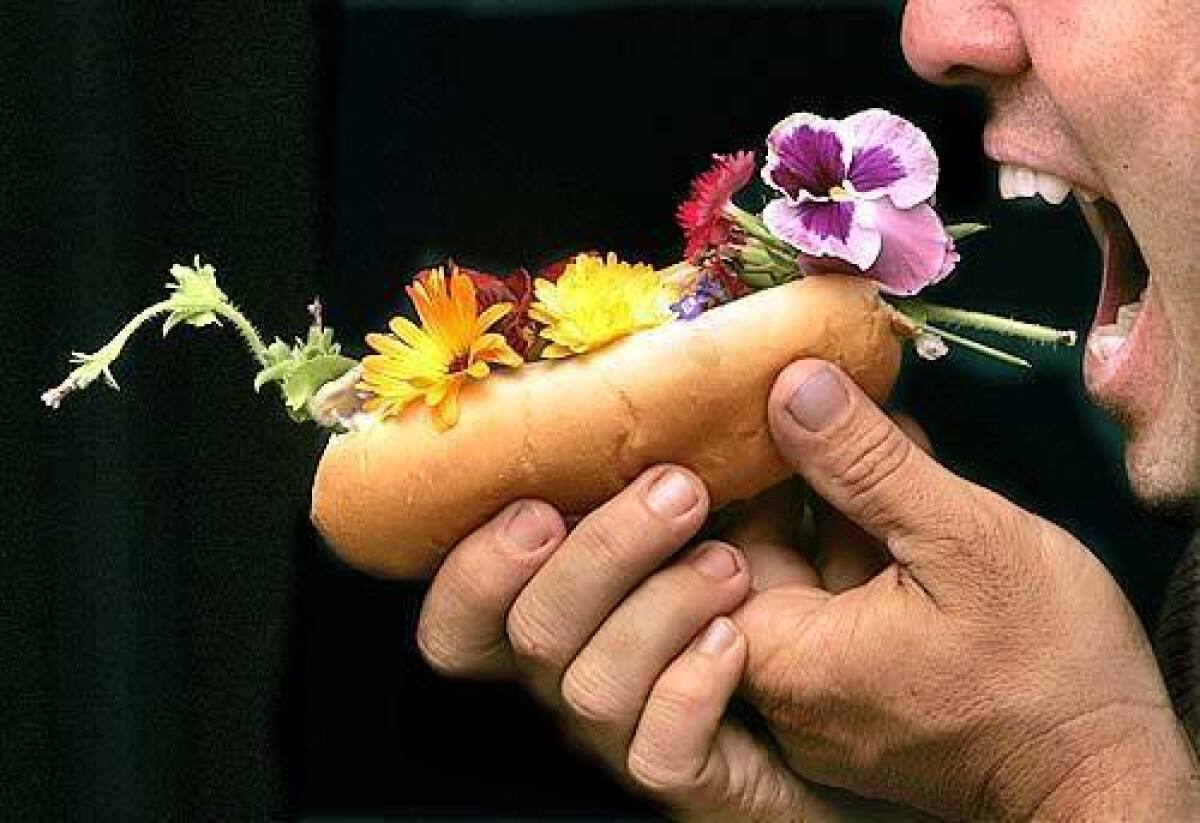Test Kitchen tips: Edible flowers

- Share via
Flowers may not be the first ingredient you think of when garnishing a dish, but they’re perfect for adding bright color -- not to mention flavor -- to a host of sweet and savory recipes. Sprinkle tender buds in salad, laminate pastry sheets with colorful petals, or stuff whole blossoms with any of a number of fillings. The options are almost endless.
If you decide to add flowers to a recipe, make sure that the flowers are indeed edible. Like mushrooms, some flowers can be harmful or even poisonous if eaten -- be sure you know what you’re playing with before adding any flowers to a recipe.
Likewise, make sure the flowers haven’t been sprayed with any pesticides. If you’re picking from your own garden, make sure it’s from a spot your dog or cat can’t mark as its own.
You can often find edible flowers in the produce section of well-stocked grocery stores and gourmet markets; if purchasing flowers, be sure to buy them from produce suppliers (flowers from florists may have been sprayed with pesticides).
Freshly picked flowers should be used the day they’re harvested because they can wilt quickly. Purchased flowers can keep up to several days, tightly wrapped and refrigerated.
The New Food Lover’s Companion gives a great list of options in its edible flowers entry:
“Some of the more popular edible flowers are: the peppery flavored nasturtiums; chive blossoms, which taste like a mild, sweet onion; pansies and violas, both with a flavor reminiscent of grapes, and perfumy, sweet roses. Other edible flowers include: almond, apple, borage, chamomile, lavender, lemon, lovage, mimosa, orange, peach, plum and squash blossoms, chrysanthemums, daisies, geraniums, jasmine, lilacs, marigolds and violets.”
If you have any kitchen tips or questions you’d like me to explore, leave a comment below or shoot me an email at noelle.carter@latimes.com.
ALSO:
Go behind the scenes at the Test Kitchen
134 recipes for your favorite restaurant dishes
Browse hundreds of recipes from the L.A. Times Test Kitchen
You can find Noelle Carter on Facebook, Google+, Twitter and Pinterest. Email her at noelle.carter@latimes.com.
Butter cupcakes
Total time: 45 minutes
Servings: 20 standard cupcakes
1 1/2 cups (6.4 ounces) all-purpose flour
1 cup (4 ounces) cake flour
3/4 teaspoon baking powder
1/2 teaspoon baking soda
3/4 teaspoon salt
3/4 cup (1 1/2 sticks) butter, at room temperature
1 cup sugar
2 eggs, at room temperature
2 egg yolks, at room temperature
2 teaspoons vanilla
2/3 cup sour cream, at room temperature
1. Heat the oven to 350 degrees. In a medium bowl, sift together the flours, baking powder, baking soda and salt.
2. In the bowl of a stand mixer using the paddle attachment, or in a large bowl using a hand mixer, cream together the butter and sugar at medium speed until the mixture is light and airy, about 5 minutes. Scrape the sides as needed for even mixing.
3. With the mixer running, mix in the whole eggs, then the yolks, one at a time, until fully incorporated. Mix in the vanilla until just combined.
4. Mix in the combined dry ingredients and sour cream, alternating between the two (one-third of the dry, then half of the sour cream, in stages) until both are thoroughly combined, being careful not to over-beat.
5. Evenly spoon the batter into 20 lined cupcake pans; the batter should fill each liner two-thirds to three-fourths full. Bake the cupcakes, one pan at a time and in the center of the oven, until the cupcakes have risen and a toothpick inserted into the center comes out clean, 15 to 20 minutes. Rotate the pan halfway through for even baking.
6. Remove the pan to a rack to cool before frosting the cupcakes. The cupcakes are best eaten the same day they are made.
Each cupcake: 185 calories; 3 grams protein; 23 grams carbohydrates; 0 fiber; 9 grams fat; 5 grams saturated fat; 64 mg. cholesterol; 151 mg. sodium.
Buttercream frosting
Total time: 35 minutes
Servings: Makes about 6 cups, enough for 2 to 4 dozen cupcakes
Note: This recipe works best with a stand mixer; the large whisk allows the buttercream to achieve better volume and stability than with a hand mixer.
1 1/2 cups sugar
1 tablespoon corn syrup
5 egg whites
3 cups (6 sticks) butter, cubed, room temperature
1. In a heavy-bottom medium saucepan, combine the sugar and corn syrup with one-half cup water and mix together to wet the sugar. Bring the mixture to a boil and cook until a candy thermometer inserted reads 238 degrees. Immediately remove from heat to stop the cooking process.
2. While the sugar is cooking, beat the eggs to soft peaks in a stand mixer using the whisk attachment, or in a large bowl with a hand mixer.
3. With the mixer running, beat the sugar syrup into the egg whites to form a meringue and continue beating until the meringue cools to room temperature, 10 to 15 minutes. (It is important that both the meringue and butter be at room temperature or the buttercream will separate.)
4. With the mixer running, beat in the butter, 1 to 2 pieces at a time, until all of the butter is incorporated. The buttercream can be made and refrigerated, covered, a few days in advance but should come to room temperature before it is used (beat the buttercream once more just before using to make sure it is emulsified).
Each 2 tablespoons: 129 calories; 1 gram protein; 7 grams carbohydrates; 0 fiber; 12 grams fat; 7 grams saturated fat; 31 mg. cholesterol; 8 mg. sodium.
More to Read
Eat your way across L.A.
Get our weekly Tasting Notes newsletter for reviews, news and more.
You may occasionally receive promotional content from the Los Angeles Times.











